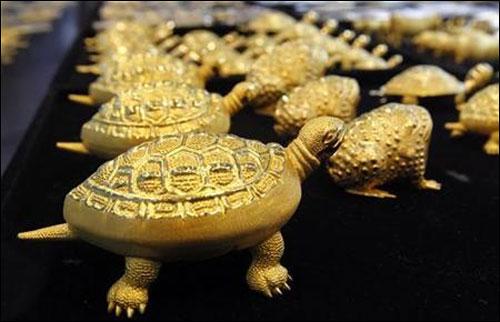Photographs: Krishnendu Halder/Reuters Business Standard
Gold prices, which have been falling for the last six months, have a major impact on the current account deficit.
The precious metal is the second-largest item in the import bill.
The current account deficit is running at $75 billion, and gold imports at $42 billion (April 2012-January 2013) account for over half that.
Indian households are the biggest gold bugs in the world; they hold, according to some estimates, over 25,000 tonnes.
The precious metal is now in the middle of the longest correction of the last 15 years, with the price down 15 per cent from the all-time highs of 2012.
. . .
Why and when does gold fall
Photographs: Ajay Verma/Reuters
If the trend continues, it could considerably ease worries on the external front.
Given that the first 10 months of 2012-13 saw imports of $42 billion, full-year imports will be lower than the $56 billion imported in 2011-12.
But in January 2013, as prices fell, the month's imports rose 23 per cent in volume terms, to over 100 tonnes.
This spike was partly driven by speculation that import duty would be hiked in the Budget, which was not the case.
. . .
Why and when does gold fall
Photographs: Parth Sanyal/Reuters
However, if demand is elastic enough, the fear is that the import bill may actually increase despite lower prices.
Indian prices track international prices closely, with a premium in the festive season as weddings account for a base demand of about 500 tonnes.
The traditional fascination with gold has been reinforced by a 10-year bull run, at a compounded annual growth rate of over 19 per cent.
. . .
Why and when does gold fall
Image: A salesgirl shows a gold necklace to customers at a jewellery showroom in Chandigarh.Photographs: Ajay Verma/Reuters
Gold went up from about $300/ounce (about $11 a gram) in 2002 to an all-time high of above $1,900 ($66 a gram) in mid-2012 before dropping back to the current $1,600 ($53 a gram).
In the past three years, its value as a hedge has also come into play as consumer inflation ran high.
The reputation as a hedge against currency weakness and inflation may have been self-fulfilling.
. . .
Why and when does gold fall
Photographs: Jo Yong-Hak/Reuters
As fears of currency weakness developed, legendary traders such as George Soros and John Paulson took massive positions, driving prices up.
The Indian government has tried several measures to reduce domestic gold demand, without much success.
The import duty has been raised from two per cent to six per cent in phases.
It cannot be raised further without attracting smuggling on a large scale.
The 2013-14 Budget introduced the concept of inflation-indexed bonds, which may be an alternative hedge.
. . .
Why and when does gold fall
Image: A model wears traditional gold jewellery as she poses for a photo session.Photographs: Jayant Shaw/Reuters
Such an instrument would have to be structured and marketed in a fashion that appeals to conservative housewives, who view gold as a default asset.
Lower gold prices are undoubtedly a relief to the finance minister.
But the interplay between price and demand elasticity could yet prove to be crucial for the current account deficit.
Expectations have been conditioned by the long bull run. Indian households will buy into corrections, while they believe prices will revert to last year's highs.
. . .
Why and when does gold fall
Image: A customer tries on a gold necklace at a shop in Hanoi, Vietnam.Photographs: Nguyen Huy Kham/Reuters
Expectations will change only if the price falls steadily over a long period, or there is a sudden, sharp drop.
Alternatively, if economic activity picks up, investors may seek higher returns from other assets.
If the government wants households to reduce their exposure to gold, it must try to enable growth and create attractive alternative investment avenues and instruments, rather than wait passively for trends to play out in the yellow metal.









article